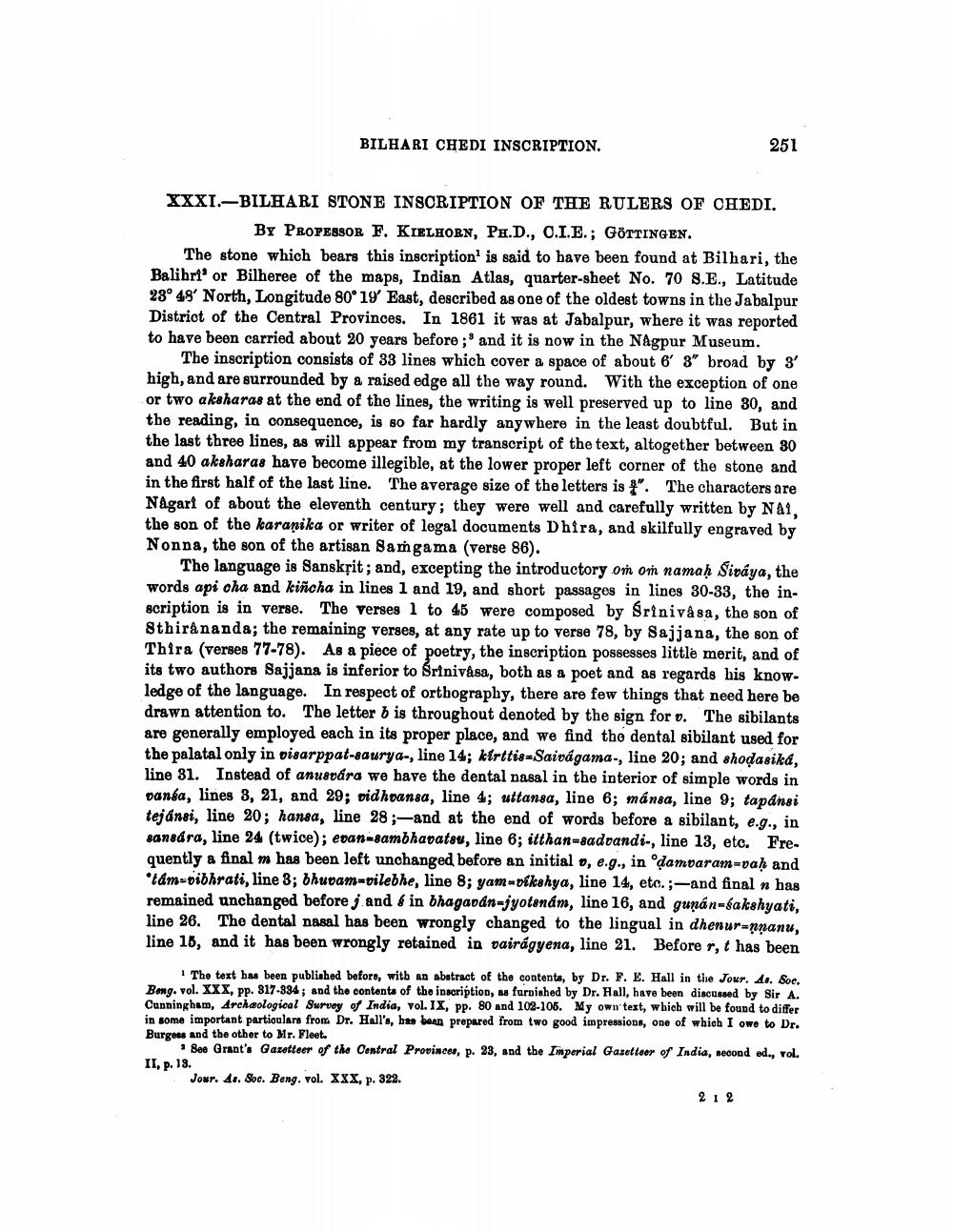________________
BILHARI CHEDI INSCRIPTION.
251
XXXI.-BILHARI STONE INSCRIPTION OF THE RULERS OF CHEDI.
BY PROFESSOR F. KIELHORN, PH.D., C.I.E.; GÖTTINGEN. The stone which bears this inscription' is said to have been found at Bilhari, the Balibri' or Bilheree of the maps, Indian Atlas, quarter-sheet No. 70 8.E., Latitude 23° 48' North, Longitude 80° 19 East, described as one of the oldest towns in the Jabalpur District of the Central Provinces. In 1861 it was at Jabalpur, where it was reported to have been carried about 20 years before ;8 and it is now in the Nagpur Museum.
The inscription consists of 33 lines which cover a space of about 6' 3" broad by 3' high, and are surrounded by a raised edge all the way round. With the exception of one or two aksharas at the end of the lines, the writing is well preserved up to line 30, and the reading, in consequence, is so far hardly anywhere in the least doubtful. But in the last three lines, as will appear from my transcript of the text, altogether between 30 and 40 aksharas have become illegible, at the lower proper left corner of the stone and in the first half of the last line. The average size of the letters is *". The characters are Någart of about the eleventh century; they were well and carefully written by Nai, the son of the karanika or writer of legal documents Dhira, and skilfully engraved by Nonna, the son of the artisan Samgama (verse 86).
The language is Sanskrit; and, excepting the introductory om oṁ namah Sivaya, the words api cha and kiñcha in lines 1 and 19, and short passages in lines 30-33, the inscription is in verse. The verses 1 to 45 were composed by Srinivasa, the son of 8thirananda; the remaining verses, at any rate up to verse 78, by Sajjana, the son of Thira (verses 77-78). As a piece of poetry, the inscription possesses little merit, and of its two authors Sajjana is inferior to Srinivasa, both as a poet and as regards his knowledge of the language. In respect of orthography, there are few things that need here be drawn attention to. The letter 6 is throughout denoted by the sign for o. The sibilants are generally employed each in its proper place, and we find the dental sibilant used for the palatal only in visarppat-saurya-, line 14; kérttis-Saivágama., line 20; and shodasika. line 31. Instead of anusvára we have the dental nasal in the interior of simple words in Dansa, lines 3, 21, and 29; vidhoansa, line 4; uttansa, line 6; mánsa, line 9; tapansi tejánsi, line 20; hansa, line 28;-and at the end of words before a sibilant, e.g., in sansdra, line 24 (twice); epan=sambhavatsu, line 6; itthan-sadvandi-, line 13, etc. Frequently a final m has been left unchanged before an initial o, e.g., in odamvaram=vah and 'tám-dibhrati, line 3; bhuvam=cilebhe, line 8; yam=víkshya, line 14, etc.;-and final n has remained unchanged before j. and 6 in bhagavan=jyotenám, line 16, and gunán=fakshyati, line 26. The dental nasal has been wrongly changed to the lingual in dhenurunnanu, line 18, and it has been wrongly retained in vairágyena, line 21. Before r, t has been
1 The text has been published before, with an abstract of the contents, by Dr. F. E. Hall in the Jour. 41. Soc. Bong. vol. XXX, pp. 317-334; and the contents of the inscription, as furnished by Dr. Hall, have been discussed by Sir A. Cunningham, Archeological Survey of India, Vol. IX, pp. 80 and 102-106. My own text, which will be found to differ in some important particulars from Dr. Hall's, bao bean prepared from two good impressione, one of which I owe to Dr. Burgess and the other to Mr. Fleet
Bee Grant's Gazetteer of the Central Provinces, p. 23, and the Imperial Gazetteer of India, second ed., vol. II, p. 13. Jour. 41. Soc. Beng. vol. XXX, p. 322.
2 1 2




